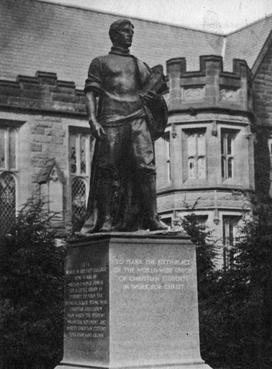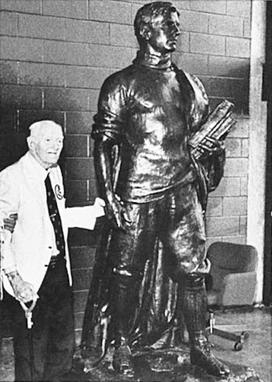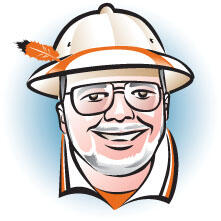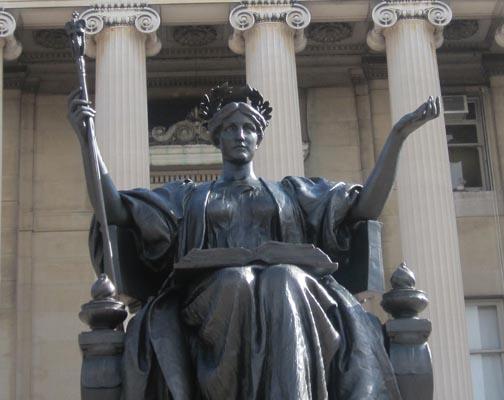Knowledge is good.
— Quotation engraved beneath the campus statue of Emil Faber, Animal House, 1978
As centennials go, this is a fascinating time here in Tigertown. For breadth of scope and impact on the culture, 1913 is tough to beat: the inauguration of Woodrow Wilson 1879 to a presidency he might be able to conclude successfully for a change (spoiler alert: he didn’t); the dedication of the first Graduate College in America by his triumphant rival, Dean Andrew Fleming West 1874 *; the senior football and hockey seasons of the mythical Hobey Baker 1914, whom we’ll discuss in the fall.
But wait, there’s more.
Fascinatingly, it begins with a true proto-Hobey, William Earl Dodge 1879, magna cum laude class leader, star and captain of the national championship football team of 1877, gifted speaker, devout Christian, and scion of the Phelps Dodge resources corporation. A pillar of the Philadelphian Society, the campus Christian student association, he led the meeting of the group on Nov. 18, 1876, in East College that launched the collegiate branch of the International YMCA. And like Hobey, five years after his celebrated graduation from the College, Earl Dodge was dead, in his case of a misdiagnosed raging infection.
His devoted brother, fellow friend of classmate Wilson, and eventual president of Phelps Dodge, Cleveland H. Dodge 1879 in some ways never got over his brother’s death. In 1900, he donated a memorial to his brother, Dodge Hall, a grander expansion of the society’s offices in modest Murray, joined to it by the same cloister you see today and still used for campus religious activities. When Wilson ascended to the Princeton presidency in 1902, Cleveland Dodge was instrumental in raising the funds for 1879 Hall, then became a trustee in 1904. After West’s triumph and Wilson’s departure to run for governor in 1910, Cleveland tried to guide the selection committee for the new president, but ended up quitting not only the committee but the board in disgust as the deep lingering rifts of the Grad College battle made progress impossible. By then he had approached Daniel Chester French, the famed heroic sculptor, about another tribute to brother Earl. French’s track record on campuses was impressive, including the bronze John Harvard statue in Harvard Yard and the Alma Mater statue in front of Low Library at Columbia, as well as the stone sculptures of Ben Franklin and Joseph Henry on Palmer Lab. But Dodge envisioned a monument to both Earl and the founding of the student Christian group, and things got muddled. The result, dedicated on May 30, 1913, opposite Murray-Dodge where East College had stood, became known as the Christian Student.
That was not its actual name, which is a dead giveaway to the failure of the project. French, 60 years old and at the height of his powers – his work on the Lincoln Memorial began the following year – was ill at ease from the very beginning, unable to envision the import that Cleveland gave to the two levels of the work. He was given pictures of Earl to work with, so obviously it was to be an homage, but the combined unworldly idealism of the religious movement and the virtues of the All-American Student Athlete (before the NCAA and ESPN came along) were a heavy burden for a lone figure to bear, and in some ways it didn’t. The resulting Rock of Ages version of Earl, in football pants and sweater with an academic gown draped over his arm and books being cradled like a pigskin, was simultaneously unapproachable and intimidating (for the opposite in heroic sculpture, look at Alma Mater). The folks who handle French’s estate have the piece catalogued as Earl Dodge Memorial (The Princeton Student), which I suspect is what the sculptor thought it should have been, but he was asked to go further. And to ensure the message was too blatant, Cleveland Dodge mounted it on a marble pedestal with much verbiage, including only the following on the front: To Mark the Birthplace of the Worldwide Union of Christian Students in Work for Christ. Although gratefully accepted by President John Grier Hibben 1882, an ordained minister and peacemaker between the West and Wilson factions, it thus became known as The Christian Student immediately, and not in a good way. Seventeen years of undergrads detested it; the most cogent explanation came many years later in the Prince. “He held up an impossible ideal to the students and he annoyed the hell out of them. He was so virtuous and terribly phony. … ‘The Christian Student’ was the perfect Princeton gentleman. He was perfectly disgusting.” That brusque summation is from Fred Fox ’39, not only the kindest person ever put on this Earth, but an ordained minister himself.

In the early ’20s, empty gin bottles began to appear nestled into the statue, efficiently commenting both on its perceived message and Prohibition. Then garbage cans appeared. Then various pink silk undergarments. Its first mocking excursion away from the pedestal took place following Commencement in 1927, to be followed by various impromptu campus parades, mainly on football weekends. Why it wasn’t just soldered down is a complete mystery. It was painted gold, then bright orange. It was tarred and feathered. In a mesmerizing PAW article many years later (May 4, 1981), Clifton Read ’29 described its penultimate journey around campus in which he participated (along with at least one classmate who became a clergyman) the night following his graduation, but had great difficulty explaining, even 52 years later, why the derisive parade happened, beer notwithstanding. A classmate opined that “this embodiment of virtue was hypocritical and smug, leaving out of the picture the real troubles of the world and what we ought to be doing about them.” Then the Depression hit, and the real troubles descended. On Oct. 29, 1930, came the final blowup: A football pep rally aborted, and restless students grabbed the statue and headed for Nassau Street. Dean Christian Gauss got hoisted into the air by the crowd along with it, and 43 students were disciplined, four of them expelled for a year. The Christian Student and its base vanished (donor Cleveland Dodge by that time was dead, so couldn’t be offended), but remarkably in 1933 a group of students searched it out in a University storage garage – and tossed it into Lake Carnegie. It then went further underground.
Sought out later by the keepers of Chesterwood, French’s estate and memorial site in Massachusetts, the statue was liberated from further underground in 1965 and put on display (without the marble verbiage of course). No one trashed it there, no one painted it, no one left gin bottles; life in the Berkshires, if placid, was at least nonthreatening.

After decades of the exile, Fred Fox’s classmate and Princetoniana successor Bud Wynne ’39 in 1987 put together two of the dozens of creative Tiger-flavored ideas that perpetually surrounded him: the statue’s return from the mountaintop, and a suitable tribute to yet another living legend, Harland “Pink” Baker ’22. Baker originally had gained fame as one of the three defenders who on fourth and goal preserved the 21-18 win over Amos Alonzo Stagg’s Chicago Maroon in 1922 with the Team of Destiny. Then, for 60 years he became the selfless soul of Princeton football, most especially its vulnerable freshmen, whom he recruited, counseled, and guided through their transition to college and big-time sports. The Football Association wanted to honor him, and his personal virtues and generosity were very much those of Earl Dodge (if not of The Christian Student caricature). With the blessings of the Chesterwood conservators, The Princeton Student (ironically, it would appear from contemporaneous accounts that the new donors thought they were changing the name) made its return to Old Nassau (on a very plain base) in the lobby of Jadwin Gym as a tribute to Baker and, by extension, Tiger freshman football players of all generations.
It’s entirely my imagination, of course, but I like to think Earl looks more relaxed these days than he did atop his marble bull’s-eye; certainly representing such a warm character as Pink and the current Ivy idea of the scholar-athlete is an easier burden than standing in for all of organized Christianity, with its considerable track record of complex troubles. Earl’s classmates always insisted that he was the most modest of men, simply a natural and inspirational leader. In Cleveland Dodge, he had a worshiping brother (in every sense, clearly), but in Pink Baker, he may have finally found a soul mate.
*If you’re coming to Reunions 2013, stop by at 3 p.m. Friday for a great mini-symposium on the centennial of the Graduate College, grandly entitled “The Thrilla on the Hill-a,” including the legendary professor emeritus John Fleming *63, Associate Dean Karen Jackson-Weaver ’94, historian W. Barksdale Maynard ’88, and preservation architect Michael Mills ’73.














No responses yet